Want to make bread but don't have yeast and need it to be dairy-free? No problem! Try making this vegan soda bread using plant milk, bicarbonate of soda, lemon juice, plain flour and a pinch of salt!

My preference when making this delicious vegan soda bread is unsweetened soya milk as it's rather thick and holds together well, curdling in a very similar way to dairy milk.
So, how does vegan soda bread rise without yeast?
Bicarbonate of soda is a leavening agent, which means that when it's added to recipes like cookies to cakes, it helps them to rise.
Leavening agents work by reacting during baking to releases gases that cause the dough or batter to expand.
In standard bread, that leavening job is done by yeast reacting with moisture. In soda bread, the job is done by bicarbonate of soda reacting with lemon juice to produce gas.
But why do they react to each other? Well, bicarbonate of soda is alkaline, which means it has a high pH. Meanwhile, lemon juice is acidic and has a low pH. When the two meet in the dough, they start to fizz together, causing the release of gas and giving your bread a lovely structure.

Ingredients
- 500 g (3⅓ cups) plain white flour (all purpose flour)
- 1 tsp salt
- 1 tsp bicarbonate of soda (baking soda)
- 400 ml (1 cups + 3 tbsp) unsweetened plant milk I recommend unsweetened soya milk
- 2 tbsp lemon juice

Preheat the oven to 200C (180C fan).
Measure out the plant milk in a jug.

Add the lemon juice.

Mix the two together and set aside for five minutes.
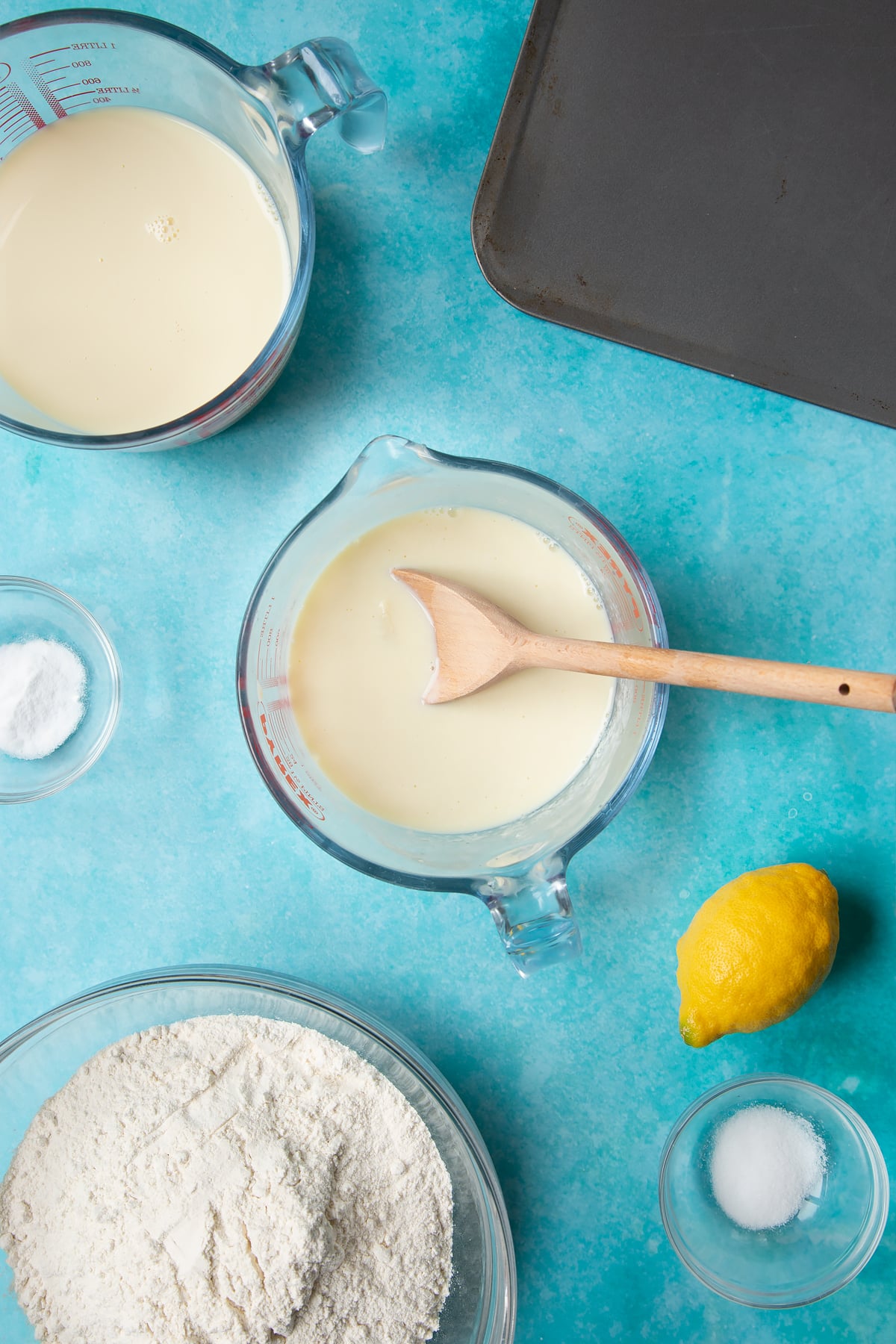
Measure the flour into a bowl.

Add the bicarbonate of soda and salt.

Mix and form a well in the centre.

Check on your plant milk. If it looks curdled, it's ready.

Pour your milk into the well in your flour bowl.

Mix together. The dough will seem super wet but don't worry - that's how it's supposed to be.

Generously flour your work surface.

Tip your vegan soda bread dough out of the bowl.

Cover with another dusting of flour.

Shape into a round.

Transfer to a floured baking tray.

Use a sharp knife to cut an X into the top of your bread.

Bake in the oven for 40 minutes.
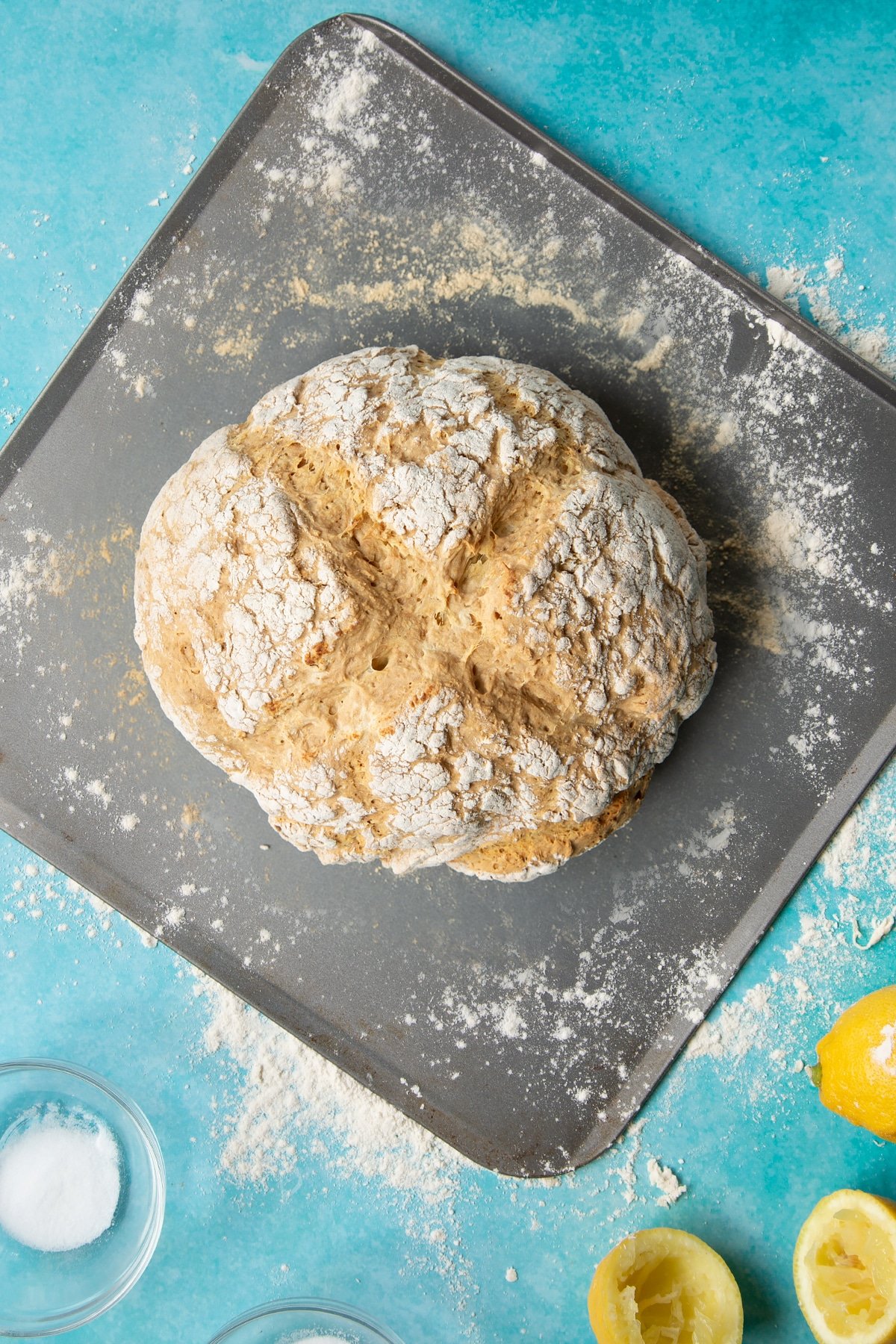
Cool on a wire rack, covered with a tea towel.

Cut into slices with a serrated knife and enjoy!

Pointers, tricks and troubleshooting tips for the perfect vegan soda bread
Why is it called soda bread?
Soda bread is so-called because of the magic ingredient that makes it rise: bicarbonate of soda!
Is vegan soda bread easy to make?
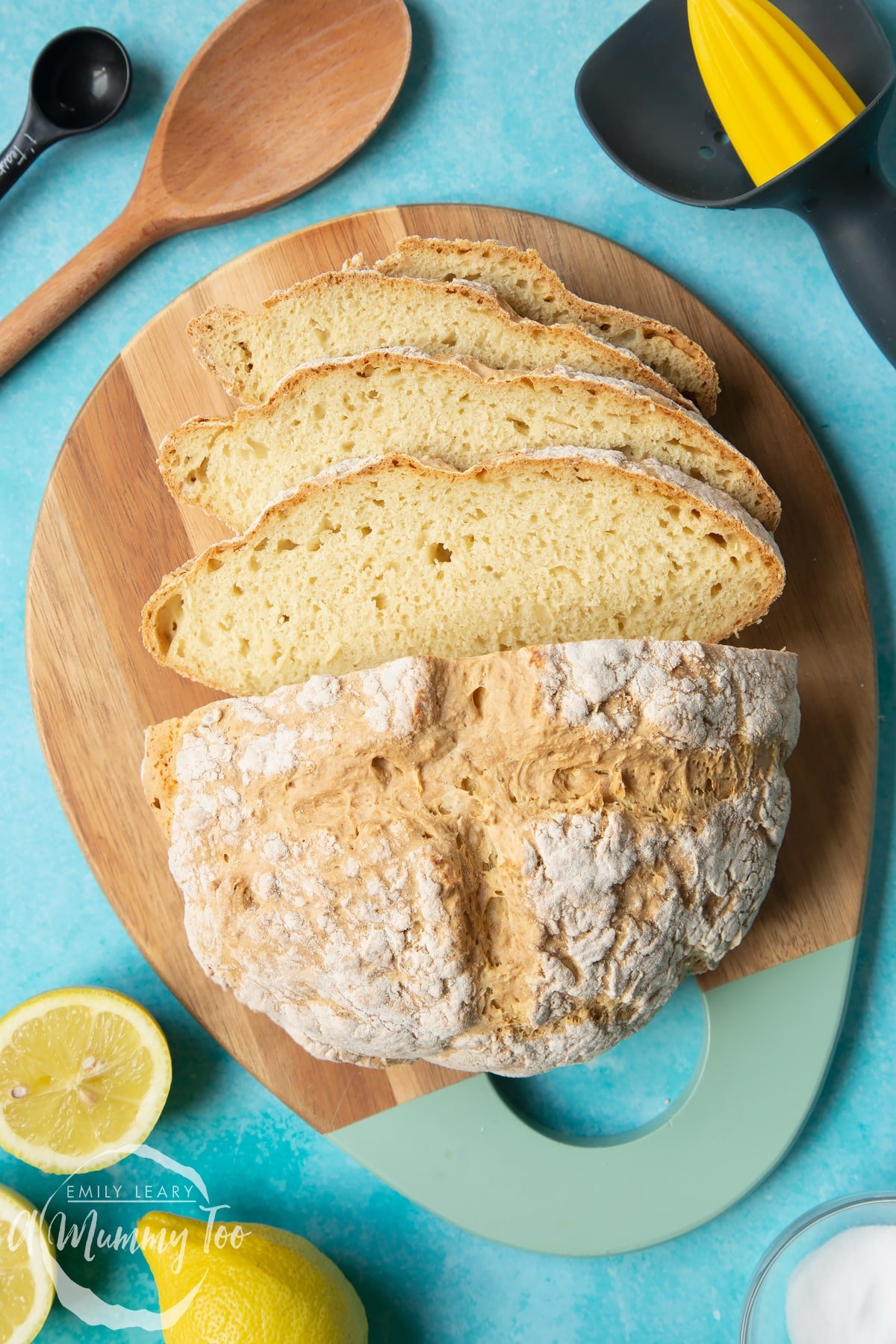
Yes, vegan soda bread is super easy to make!
You need only five ingredients to make it (plant milk, bicarbonate of soda, lemon juice, plain flour and a pinch of salt) and then it's just a case of mixing the lemon juice with the plant milk before combining it with the flour, salt and bicarb, shaping into a loaf and baking!
It's virtually impossible to mess up and the results are delicious!
Will I need any special equipment to make vegan soda bread?
You don't need any special equipment to make vegan soda bread!
As long as you have weighing scales, a mixing bowl and a baking sheet you are all set!
Where can I buy bicarbonate of soda?
Bicarbonate of soda is also known as baking soda or bicarb. You can buy in pretty much every supermarket. You will usually find it in the baking aisle, next to the baking powder and cream of tartar.
What sort of plant milk works best for this recipe?
You can use any sort of plant milk in this vegan soda bread recipe but I find unsweetened soya milk works best because it is quite a thick milk and curdles well once you add the lemon juice, and it adds very little flavour to the finished bake.
Is this recipe suitable for vegetarians and vegans?
Yes, vegan soda bread is completely suitable for vegetarians and vegans as it contains only plant milk, bicarbonate of soda, lemon juice, plain flour and a pinch of salt.

Is this vegan soda bread gluten-free?
This recipe is not gluten-free as it uses wheat flour as the main ingredient.
I haven't tried making a gluten-free version myself yet but there's a good chance it would work, since this bread recipe doesn't require kneading.
If you give it a go, I'd recommend a good quality gluten-free baking flour with xanthan gum. Let me know how you get on!
Is vegan soda bread keto-friendly?
The main ingredient in vegan soda bread is flour, so it is not suitable for a keto diet.
Is vegan soda bread healthy?
In terms of nutritional value, vegan soda bread isn't much different from standard yeasted bread.
It is high in carbohydrate, which may be significant depending on your dietary needs, but for most people, bread can be enjoyed in moderation as part of a healthy, balanced diet.
Is this vegan soda bread safe to eat while pregnant?
There is nothing in this vegan soda bread recipe that should present a risk to pregnant people if the ingredients are in good condition and have been stored correctly, and the recipe is cooked hygienically and safely.
However, this is not medical advice and you should always check with your health professional. The NHS also has an excellent resource on foods to avoid in pregnancy.
What goes well with vegan soda bread?

This is a deliciously versatile bread that can be enjoyed in all sorts of ways, from fresh sandwiches to indulgent toasties. Or simply enjoy it with a thick layer of vegan butter!
Can I make this recipe without bicarbonate of soda?
I'm afraid bicarbonate of soda is a vital ingredient in vegan soda bread.
If you'd like to make a different vegan bread, try this fun plant pot bread, using vegan butter and milk in place of the dairy ingredients.
I haven’t got lemon juice, what else can I use?
If you haven't got lemon juice, you can still make vegan soda bread.
Any sort of vinegar can be used in the same quantity to bring the acid element into the recipe. White wine vinegar is ideal. Stronger flavoured vinegar types may impact the flavour of the finished bread.
Can I add extra flavours to this recipe?
You can add any flavours you like to vegan soda bread! Just stir the extra flavours into the dough before you shape it.
How about rosemary and sea salt, vegan cheese and onion and even chocolate chip?
How should I store vegan soda bread?
Vegan soda bread should be wrapped well and stored in a cool container such as a bread bin to help keep it fresh for as long as possible.
How long does vegan soda bread recipe keep?
Vegan soda bread is best eaten on the day it's baked, but it will keep for at least a couple of days before starting to go stale and will still be good to enjoy as toast for a couple more.
Can I leave vegan soda bread out on the counter?
It won't harm your bread to leave it on the counter, but it will go stale more quickly, so it's best to wrap it well and pop it in your bread bin.
Can I keep vegan soda bread in the refrigerator?
You definitely shouldn't put your vegan soda bread in the fridge. In fact, you shouldn't put really put any wheat bread in the fridge.
You might think that everything stays fresher when refrigerated, but the starch in bread doesn't react well to the cold and will crystallise, meaning your bread will actually go stale faster!
Can I freeze vegan soda bread?

You can freeze vegan soda bread. You can either freeze is as a whole loaf, well-wrapped to be as airtight as possible, or you can slice and freeze.
If slicing before freezing, I'd recommend putting a little baking paper between each slice and placing an airtight container with as little empty space inside as possible to reduce the likelihood of freezer burn. That way, you can grab a slice or two from the freezer whenever you need it.
Your frozen slices can be left, wrapped to come up to room temp, or you can put them straight from freezer to toaster, as long as the slices don't have any signs of frost in them (which could turn to water inside the toaster!)
Can I toast vegan soda bread?
You absolutely can toast vegan soda bread. In fact, it's my favourite way to enjoy it.
The loaf in this recipe is pretty large, so you might find you need to either cut your slices in half or rotate them halfway through toasting to get an evenly toasted crumb.
Can I make this vegan soda bread in a different size?
Yes, you can size this loaf up and down
Simply scroll down to the recipe card towards the bottom of this post and hover your mouse (or tap your finger) over the portion number.
You will then be shown a slider, which you can move up and down to change the number of portions the recipe will give. As you do so, all of the ingredient quantities will automatically change accordingly. Clever, right?
Of course, if you significantly reduce or increase the size of this recipe, it may affect the cooking time, so keep an eye on your loaf as it bakes and use your judgement to decide how long it might need.
If you have any questions about changing the quantities, just ask!
Can I make vegan soda bread in individual rolls/buns?
You can absolutely turn this vegan soda bread recipe into buns!
When you get to the stage in the recipe where you tip your dough onto a floured surface and form into a round, simply cut that round into 8 equal wedges.

Then roll each one up!

Make sure to bake them spaced well apart to give them room to expand.

(Note: the above images show pink dough because they're from my vegetable soda bread rolls recipe, which includes beetroot as an ingredient!)
Can I make vegan soda bread in a tin/tray?
You can indeed make soda bread in a tin and it should work well. A 500g (1lb) loaf tin should do the trick.
Can I make vegan soda bread in a stand mixer or food processor?
You could mix your vegan soda bread dough in a stand mixer or food processor with paddle attachment if you wish, but the recipe requires very little mixing so for most people it will be easier to do it by hand in a mixing bowl.
How can I make sure my vegan soda bread is perfectly cooked?
When you look at your vegan soda bread in the oven, it might look cooked after as little as 15 minutes, but you really need to allow it the full baking time to be fully baked through, otherwise you could end up with a stodgy middle.
Obviously, some ovens run hotter than others, so if it looks like your bread is overcooking or burning, use your judgment.
Why did my vegan soda bread turn out really hard?
When you first take your vegan soda bread out of the oven, the crust will seem super hard and thick but don't worry! Cover your hot bread with a tea towel and it will soften up a lot as it cools.

Why did my vegan soda bread turn out wet / soft / undercooked?
If your soda bread seems wet or undercooked, it's likely to be for one of two reasons.
First, it might be that you added too much plant milk or not enough flour. Follow the quantities provided carefully.
Second, it could be that you didn't bake your bread for long enough. If you baked it for the full 40 minutes and it came out doughy, it may be that your oven runs cold. I would suggest investing in an oven thermometer.
Why didn’t my vegan soda bread rise?
If your soda bread didn't rise, it is possible that something went wrong when you were measuring out your quantities. Too little bicarb or too much lemon juice and things can go awry.
It could also be that your bicarbonate of soda has lost its potency, which can happen over time, especially after the container has been opened.
To test your bicarb, mix some warm water with a little vinegar or lemon juice, then sprinkle in a little bicarb. If it doesn't fizz, it's no good.
It's a really good idea to do this straight away the next time you get brand new bicarbonate of soda, so that you can see what the reaction should look like and compare it with the results you get when testing an old pack.
And one extra tip: this method also works for testing baking powder!
Why did my vegan soda bread split / burst?
It's normal for soda bread to be a little rustic looking, but if it seems to have burst from one place, it might be because there wasn't anywhere for the gases to escape as they formed during baking.
Cutting an X into the top of your bread will help allow the gases to escape and encourage your soda bread loaf to hold its shape.

What is the origin of soda bread?
Early European settlers to the Americas are thought to have made something similar to soda bread in the 1700s using pearl ash (aka potash or potassium carbonate) as a leavening agent.
When baking soda was invented in the US in 1840, its use in baking alongside cream of tartar (which acts as the acid to bicarb's alkaline) became popular across Europe.
Today, modern baking powder is a mixture of bicarbonate of soda and cream of tartar. When baking powder is added to cake batter, the alkaline bicarbonate of soda and acidic cream of tartar react together to create gases which help the cake rise.
Print this vegan soda bread recipe
Vegan Soda Bread Recipe
Ingredients
- 500 g (3⅓ cups) plain white flour (all purpose flour)
- 1 tsp salt
- 1 tsp bicarbonate of soda (baking soda)
- 400 ml (1 cups + 3 tbsp) unsweetened plant milk I recommend unsweetened soya milk
- 2 tbsp lemon juice
Instructions
- Preheat the oven to 200C (180C fan / 390F).
- Measure out the plant milk in a jug. Add the lemon juice. Mix the two together and set aside for five minutes.
- Measure the flour into a bowl. Add the bicarbonate of soda and salt.
- Mix and form a well in the centre.
- Check on your plant milk. If it looks curdled, it’s ready. Pour your milk into the well in your flour bowl.
- Mix together. The dough will seem super wet but don’t worry – that’s how it’s supposed to be.
- Generously flour your work surface. Tip your vegan soda bread dough out of the bowl. Cover with another dusting of flour.
- Shape into a round. Transfer to a floured baking tray. Use a sharp knife to cut an X into the top of your bread.
- Bake in the oven for 40 minutes.
- Cool on a wire rack, covered with a tea towel.
- Cut into slices with a serrated knife and enjoy!
Video
Notes
Nutrition
Pin this vegan soda bread for later

More vegan baking to try
Have you got my book?

'This is a great kids cookery book. Emily is a star' - Simon Rimmer
'The book I'd like to force into any mother's kitchen' - Prue Leith
"A fab book with a plan." - Jane Devonshire, 2016 Masterchef UK winner
'Emily has managed to combine her mummy knowledge and passion for food to make a truly helpful and brilliant cookbook' - Priya Tew, RD, BSc (Hons), Msc
Get Your Kids to Eat Anything is an achievable 'how to' for parents in the battle to overcome picky eating and 'make new the norm'. Emily Leary's unique 5-phase programme looks at the issue of 'fussy eating' in a holistic way that links imagination with food, and which situates parents alongside - not in opposition to - their children.

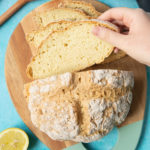
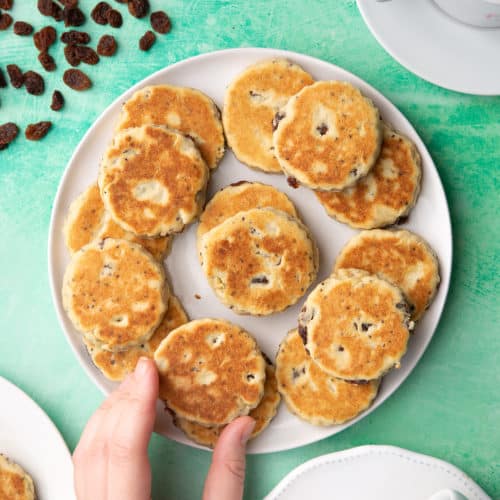




Jarrod Ryant says
thanks for sharing
Kristofer Helmig says
Up up up, good
Janet West says
Hi I would like to make it Gluten Free, buck wheat or oat flour or rice flour? Also how much of the gum should I use?
Thanks
Emily Leary says
I'm afraid I haven't tested with those flours.